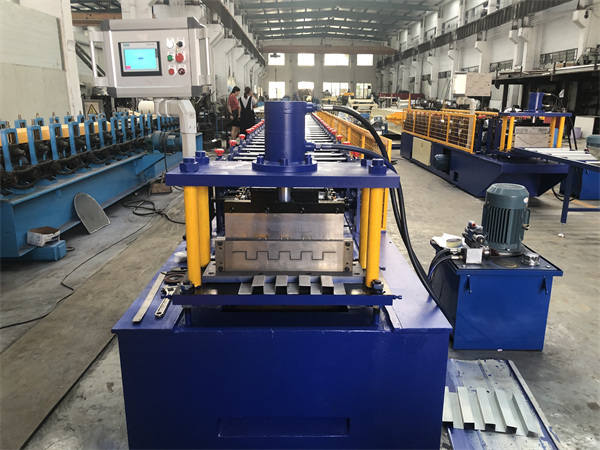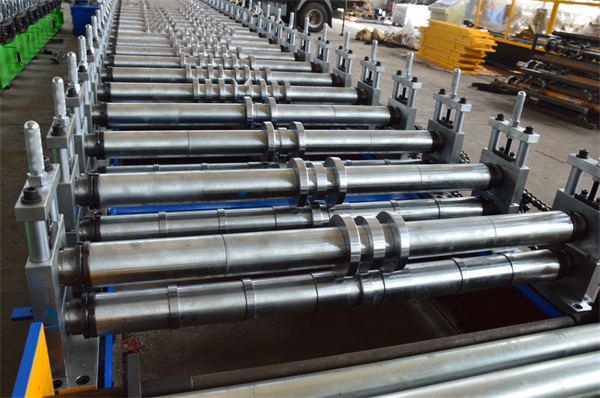Roll forming is a versatile metalworking process used to shape metal sheets and strips into desired profiles, and stainless steel roll forming machines play a crucial role in this process. In this comprehensive article, we’ll delve into the intricacies of stainless steel roll forming machines and answer the top 10 questions people have about them.
1. How does a stainless steel roll forming machine work?
A stainless steel roll forming machine operates by passing a continuous strip of stainless steel through a series of rollers, gradually bending and shaping the material into the desired profile. The machine typically consists of several pairs of rollers, each with a slightly different shape. As the metal strip goes through these rollers, it undergoes incremental shaping until it achieves the final cross-sectional profile.
The process is continuous and highly automated, making it efficient for producing large quantities of consistent profiles. Here’s a simplified breakdown of the process:
| Step | Description |
|---|---|
| 1 | Uncoiling: Stainless steel coil is unwound. |
| 2 | Material feeding: The strip is guided into the machine. |
| 3 | Roll forming: The strip passes through successive rollers to shape it. |
| 4 | Cutting: The formed profile is cut to the desired length. |
| 5 | Stacking or packaging: Finished profiles are collected. |
Roll forming machines are versatile and can create various profiles, from simple shapes to complex designs.
2. What are the advantages of using stainless steel roll forming machines?
Stainless steel roll forming machines offer several advantages:
- Cost-Efficiency: Roll forming is highly efficient for mass production, reducing labor costs and increasing production rates.
- Consistency: The process ensures consistent and precise profiles throughout production.
- Material Savings: Roll forming minimizes material waste compared to traditional fabrication methods.
- Versatility: It can create a wide range of profiles with minimal tooling changes.
- Complex Profiles: Roll forming can produce intricate profiles that might be challenging using other methods.
- Speed: The continuous process speeds up production and reduces lead times.
- Durability: Stainless steel’s corrosion resistance and strength make it ideal for various applications.
These advantages make stainless steel roll forming machines suitable for industries like construction, automotive, and appliance manufacturing.

3. What types of stainless steel are suitable for roll forming?
Stainless steel grades suitable for roll forming include austenitic, ferritic, and martensitic types. The choice depends on the application’s requirements:
| Stainless Steel Grade | Properties and Applications |
|---|---|
| 304 (Austenitic) | General-purpose corrosion resistance, aesthetic appeal. |
| 316 (Austenitic) | Higher corrosion resistance, suitable for marine environments. |
| 409 (Ferritic) | Good for high-temperature applications, exhaust systems. |
| 430 (Ferritic) | Decorative purposes, indoor applications. |
The specific grade selection depends on factors like corrosion resistance, strength, and cost considerations.
4. How does roll forming compare to other metal forming methods?
Roll forming offers several advantages over traditional metal forming methods like stamping and press braking:
- Material Utilization: Roll forming minimizes material waste compared to stamping.
- Cost Efficiency: Lower labor costs due to automation and faster production rates.
- Complex Shapes: Roll forming can create intricate profiles that may be challenging using other methods.
- Consistency: Uniform profiles throughout production, unlike press braking.
- High Production Volumes: Ideal for large production quantities.
- Speed: Continuous process reduces lead times.
However, for low-volume runs or very complex shapes, stamping or press braking might be more suitable.
5. What factors influence the design of a roll-formed profile?
Designing a successful roll-formed profile involves considering several factors:
- Material Selection: Choose a stainless steel grade based on strength and corrosion resistance.
- Cross-Sectional Complexity: The number of bends, flanges, and curves affects feasibility.
- Tolerances: Tighter tolerances require careful design to ensure consistency.
- Formability: Some shapes might require special tooling for successful forming.
- Material Thickness: Thicker materials might need more passes through the rollers.
- Post-Processing: Design for any necessary cutting, punching, or notching.
- Production Volume: High-volume runs can justify more complex tooling.
Collaboration between designers and roll forming experts is crucial for optimizing the profile design.
6. How is tooling created for stainless steel roll forming machines?
Tooling for stainless steel roll forming machines is customized for each profile. The process involves:
- Design: Engineers create detailed drawings of the tooling components.
- Material Selection: Tooling materials must withstand high pressures and wear.
- Machining: CNC machining or other methods are used to shape the tooling components.
- Heat Treatment: Tooling is heat-treated to enhance durability.
- Assembly: Components are assembled into sets that fit into the roll forming machine.
- Testing: Tooling is tested with sample material to ensure proper shaping.
- Adjustments: Fine-tuning may be necessary for optimal results.
Quality tooling is essential for consistent and accurate roll forming.

7. What maintenance is required for stainless steel roll forming machines?
Proper maintenance ensures the longevity and performance of roll forming machines:
- Regular Inspections: Check for worn or damaged components and replace as needed.
- Lubrication: Keep moving parts well-lubricated to minimize friction and wear.
- Cleaning: Remove debris and buildup to prevent defects in the profiles.
- Alignment: Ensure rollers are properly aligned for accurate forming.
- Tooling Inspection: Regularly inspect tooling for wear and damage.
- Calibration: Periodically calibrate sensors and measuring devices for accuracy.
- Training: Train operators to recognize and address potential issues.
A well-maintained machine operates efficiently and produces high-quality profiles.
8. How is quality ensured during the stainless steel roll forming process?
Maintaining quality throughout the roll forming process involves several steps:
- Material Inspection: Verify stainless steel quality before it enters the machine.
- Tooling Check: Ensure tooling is in good condition and properly aligned.
- In-Process Checks: Regularly measure formed profiles to ensure dimensional accuracy.
- Visual Inspection: Detect surface defects, scratches, or imperfections.
- Sampling: Periodically check profiles against design specifications.
- Documentation: Maintain detailed records of measurements and inspections.
- Operator Training: Properly trained operators understand quality standards.
These measures help prevent defects and deviations from design specifications.
9. Can stainless steel roll forming machines be customized for specific needs?
Yes, stainless steel roll forming machines can be customized for specific profiles and applications. Customization involves:
- Profile Design: Engineers collaborate with customers to design the desired profile.
- Tooling Creation: Custom tooling is designed and manufactured for the specific profile.
- Machine Setup: Roll forming machines are adjusted and calibrated to accommodate the new profile. 4. Process Parameters: Machine settings like speed and pressure are optimized for the specific material and profile.
- Testing: Test runs are conducted to ensure the profile meets specifications.
- Quality Assurance: Profiles are inspected to verify that they meet quality standards.
Customized stainless steel roll forming machines are ideal for unique or specialized applications that require specific shapes and dimensions.
10. What safety considerations are important when operating a stainless steel roll forming machine?
Ensuring safety during the operation of a roll forming machine is paramount:
- Training: Operators should be well-trained in machine operation, maintenance, and emergency procedures.
- Personal Protective Equipment: Operators must wear appropriate safety gear, such as gloves and safety glasses.
- Machine Guards: Roll forming machines should be equipped with guards to prevent accidental contact with moving parts.
- Emergency Stop: Machines should have easily accessible emergency stop buttons.
- Lockout/Tagout: Proper procedures must be followed when performing maintenance or repairs.
- Ventilation: Adequate ventilation is essential when working with stainless steel to avoid fume exposure.
- Regular Maintenance: Well-maintained machines are less likely to malfunction, reducing the risk of accidents.
Prioritizing safety safeguards both the operators and the quality of the roll-formed profiles.

Table Summary
Here’s a summary of the information covered in the articles:
| Article Number | Question | Key Points Covered |
|---|---|---|
| 1 | How does a stainless steel roll forming machine work? | Roll forming process, machine components, automation. |
| 2 | What are the advantages of using stainless steel roll forming machines? | Cost efficiency, consistency, material savings, versatility. |
| 3 | What types of stainless steel are suitable for roll forming? | Suitable stainless steel grades and their applications. |
| 4 | How does roll forming compare to other metal forming methods? | Advantages over stamping and press braking, when to use. |
| 5 | What factors influence the design of a roll-formed profile? | Design considerations, material selection, complexity. |
| 6 | How is tooling created for stainless steel roll forming machines? | Tooling design, material, machining, assembly, testing. |
| 7 | What maintenance is required for stainless steel roll forming machines? | Regular inspection, lubrication, cleaning, alignment. |
| 8 | How is quality ensured during the stainless steel roll forming process? | Material inspection, in-process checks, operator training. |
| 9 | Can stainless steel roll forming machines be customized for specific needs? | Customization process, profile design, machine setup. |
| 10 | What safety considerations are important when operating a stainless steel roll forming machine? | Operator training, safety gear, machine guards, emergency procedures. |
FAQ
1. What is the basic working principle of a stainless steel roll forming machine?
A stainless steel roll forming machine shapes a continuous strip of stainless steel by passing it through a series of rollers, gradually bending it into the desired profile.
2. What are the main advantages of using stainless steel roll forming machines?
Stainless steel roll forming machines offer benefits like cost efficiency, material savings, versatility, consistency, and the ability to create complex profiles.
3. Which types of stainless steel are suitable for roll forming, and what are their applications?
Stainless steel grades like 304, 316, 409, and 430 are suitable for roll forming, each with its own properties suitable for different applications.
4. How does roll forming compare to other metal forming methods like stamping?
Roll forming is advantageous in terms of material utilization, cost efficiency, consistency, complexity, high production volumes, and speed compared to stamping.
5. What factors should be considered when designing a roll-formed profile?
Factors include material selection, cross-sectional complexity, tolerances, formability, material thickness, post-processing, and production volume.
